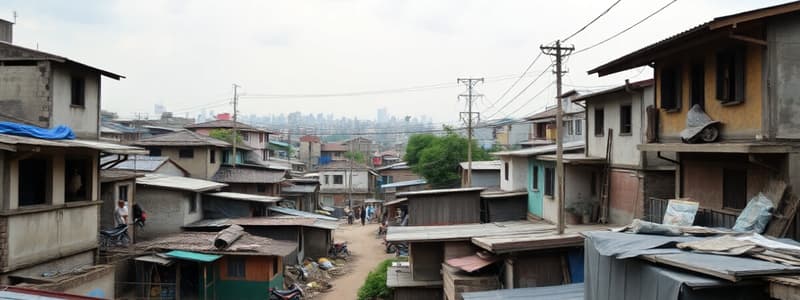Podcast
Questions and Answers
What common issue is observed in the houses described?
What common issue is observed in the houses described?
What does the second house mentioned in the description lack?
What does the second house mentioned in the description lack?
What effect did the construction of the Leeds railway extension have?
What effect did the construction of the Leeds railway extension have?
How are the living conditions in the described cabins characterized?
How are the living conditions in the described cabins characterized?
Signup and view all the answers
What describes the area immediately under the railway bridge?
What describes the area immediately under the railway bridge?
Signup and view all the answers
What is a characteristic of the inhabitants of the cabins?
What is a characteristic of the inhabitants of the cabins?
Signup and view all the answers
What do the broken windowpanes and frames in the houses signify?
What do the broken windowpanes and frames in the houses signify?
Signup and view all the answers
Which statement accurately describes the general condition of the area?
Which statement accurately describes the general condition of the area?
Signup and view all the answers
Flashcards
Slums
Slums
A densely populated area characterized by extremely poor living conditions, cramped housing, and lack of basic sanitation.
Cabin
Cabin
A very small and basic dwelling, often only one room, with a dirt floor.
Secluded
Secluded
The state of being hidden or concealed, often in a way that makes it difficult to find or access.
Paupers' cemetery
Paupers' cemetery
Signup and view all the flashcards
Viaduct
Viaduct
Signup and view all the flashcards
Thrown open to public gaze
Thrown open to public gaze
Signup and view all the flashcards
Swept away
Swept away
Signup and view all the flashcards
Breach
Breach
Signup and view all the flashcards
Study Notes
Description of Urban Slums
- Dense Housing: Houses packed closely together, especially on steep riverbanks, allowing views into many homes.
- Degradation of Housing: Houses blackened by soot, crumbling, with broken windows and frames, indicating severe disrepair.
- Background Structures: Old factory buildings resembling barracks, suggesting industrial environment.
- Opposing Bank: A long row of houses and factories visible on the opposite river bank.
- Specific Housing Examples: A roofless ruin filled with refuse, and a house built so low the ground floor is uninhabitable, highlighting extreme poverty and poor construction.
- Visible Infrastructure: Pauper's cemetery and railway stations to Liverpool and Leeds.
Impact of Infrastructure Development
- Railway Extension: A recent railway extension across the River Irk has exposed previously hidden slum courts and alleys (by creating an opening).
- Increased Visibility: The railway creates a pathway for public view into even worse conditions.
- Illustrative Example: An example of a particularly unsanitary court under the railway bridge found to be even more appalling because hidden.
- Accessibility: Described difficult access to this area before the railway.
- Accessibility: A rough path by the riverbank, between clotheslines and washing, leads to the area, illustrating the lack of proper infrastructure and the precarious nature of slum life.
Living Conditions in Slums
- Small Cabins: A chaotic group of small, one-storied, one-room cabins, the majority with earth floors.
- Limited Space: Rooms are cramped, barely six feet long and five feet wide; beds occupy most of the space, indicating extremely small living quarters with multiple functions (sleeping, working, and living) in the one space.
- Empty Homes: Many cabins appear deserted, with inhabitants leaning against doors.
- Filth and Garbage: Filth and garbage in front of the doors illustrating lack of sanitation and waste disposal.
- Inadequate Infrastructure: No visible pavement, suggesting a lack of basic urban utilities in the district.
Studying That Suits You
Use AI to generate personalized quizzes and flashcards to suit your learning preferences.
Description
Explore the characteristics of urban slums, including dense housing, degradation, and visible infrastructure. This quiz also examines the impact of railway development on slum visibility and conditions. Understand the socio-economic challenges faced by residents in these underprivileged areas.




